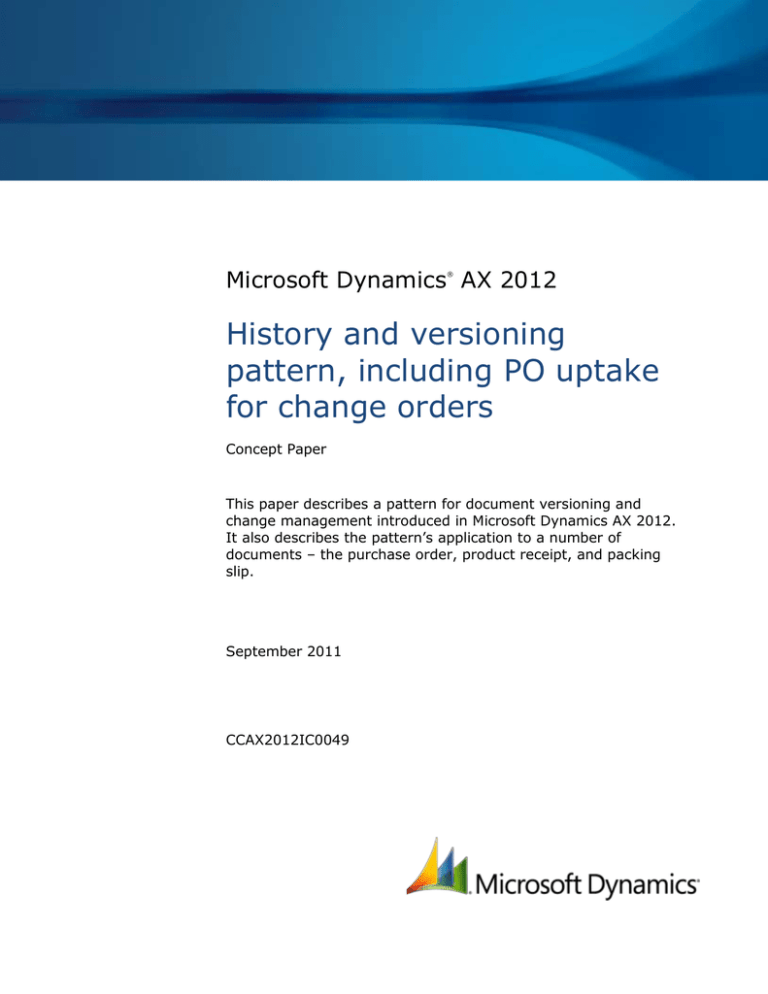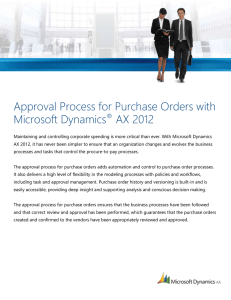
Microsoft Dynamics AX 2012
®
History and versioning
pattern, including PO uptake
for change orders
Concept Paper
This paper describes a pattern for document versioning and
change management introduced in Microsoft Dynamics AX 2012.
It also describes the pattern’s application to a number of
documents – the purchase order, product receipt, and packing
slip.
September 2011
CCAX2012IC0049
Table of Contents
Overview..................................................................................................... 3
Functionality enabled by the versioning pattern ......................................... 3
Purchase orders .................................................................................................................... 3
Earlier versions of Microsoft Dynamics AX ............................................................................. 3
Microsoft Dynamics AX 2012 PO-specific conditions ................................................................ 3
Product receipts and packing slips ........................................................................................... 4
Earlier versions of Microsoft Dynamics AX ............................................................................. 4
Microsoft Dynamics AX 2012 specific conditions ..................................................................... 4
Versioning pattern data model .................................................................... 5
Assumptions ..................................................................................................................... 5
Abstract document versioning data model ............................................................................. 5
Physical data model considerations ...................................................................................... 6
Purchase order data model..................................................................................................... 7
Packing slip data model ......................................................................................................... 8
Inventory integration and accounting implications.................................................................. 9
Version comparison ............................................................................................................... 9
Document state management ................................................................... 10
Purchase order state management .........................................................................................11
Product receipt and packing slip state management .................................................................12
2
HISTORY AND VERSIONING PATTERN, INCLUDING PO UPTAKE FOR CHANGE ORDERS
Overview
Many of the documents stored by an ERP system in a relational database are not static. They can be
changed or corrected by users based on changes in the environment they describe or when errors are
found. Microsoft Dynamics® AX 2012 introduces a pattern for how modifications to such documents
can be effectively managed and efficiently represented in the database.
This document explains how the pattern can be applied to any new or existing document where
versioning and change management functionality is desired, and also describes how the pattern was
applied to a number of standard Microsoft Dynamics AX 2012 documents.
Functionality enabled by the versioning pattern
The following are two main functional benefits of applying the versioning pattern:
Full traceability (history) of changes made to a document. At any time, a new version of the
document can be recorded. Any two versions of the document can be compared by using a generic
version comparison tool.
A standardized document state model enabling change management with workflow approvals. The
document is editable only in the draft, in review, and rejected states. A new version is recorded
upon approval.
Purchase orders
A purchase order (PO) is the most complex use of the versioning pattern in Microsoft Dynamics AX
2012. Besides the traceability and change management with workflow integration, the pattern also
enables other procurement functionality extensions, such as encumbrance accounting for confirmed
purchase orders.
Earlier versions of Microsoft Dynamics AX
In Microsoft Dynamics AX 2009 and earlier versions, users were able to change purchase orders inplace, without any trace of what they changed and when. It was not possible to set up the standard
Microsoft Dynamics AX application to require workflow approval for new or changed purchase orders.
The purchase order confirmation journal provided limited traceability, because its use was optional,
and because it contained only a subset of all order data. Every confirmation required a full copy of all
confirmation journal records, which, when used extensively, caused a lot of data duplication.
Microsoft Dynamics AX 2012 PO-specific conditions
The change management functionality for purchase orders is optional in Microsoft Dynamics AX 2012
and is turned off by default. It can be configured at the level of the legal entity, vendor, or specific
order. When it is activated, any change to order data requires workflow approval. When it is not
activated, the PO is always considered pre-approved. Intercompany, direct delivery, and
production/MRP-derived orders never have change management enabled.
3
HISTORY AND VERSIONING PATTERN, INCLUDING PO UPTAKE FOR CHANGE ORDERS
Any change that is identified as part of the contract (that is, material to the vendor) requires a new
order confirmation before an invoice or product receipt can be processed against it. This also applies
when change management is not activated for an order, and thus the change tracking functionality is
always available (that is, every confirmation creates a new version of the document).
Figure 1 Purchase order versions form
Product receipts and packing slips
Use of the pattern for product receipts and packing slips is limited to versioning, and no workflow
integration is enabled.
Earlier versions of Microsoft Dynamics AX
Packing slips were actually static documents in Microsoft Dynamics AX 2009 and earlier versions.
Users could not directly modify those documents. However, the documents could be corrected (offset)
by another packing slip document if the Receive Now/Deliver Now field was set with a sign
opposite to the sign of the order line quantity. There was no control over which packing slip was
corrected if there were multiple available.
Microsoft Dynamics AX 2012 specific conditions
Product receipt and packing slip documents can be explicitly corrected in Microsoft Dynamics AX 2012.
However, only the same types of corrections that were possible in Microsoft Dynamics AX 2009 are
supported. In other words, only the received or delivered quantity can be corrected, and only
downward.
Intercompany direct delivery packing slip corrections are also supported.
4
HISTORY AND VERSIONING PATTERN, INCLUDING PO UPTAKE FOR CHANGE ORDERS
Versioning pattern data model
The versioning pattern defines how multiple versions of a document can be stored in a relational
database to minimize data repetition and provide efficient access to any of the versions.
Assumptions
The document to be versioned has a tree structure, in which nodes are represented by records in
database tables, and parent/child relationships between nodes are represented by foreign keys
between corresponding database tables. There is no limit to the depth of the tree. Figure 2 illustrates
an abstract document model. Typically, nodes are stored in various database tables, where fields
correspond to document node–type attributes.
DocumentNode
ID
DocumentRootNode
DocumentChildNode
ID (FK)
ID (FK)
ParentNode (FK)
Figure 2 Abstract document data model
Abstract document versioning data model
DocumentVersion
DocumentNodeHistory
ID
RootNode (FK,AK1)
VersionDateTime (AK1)
IsArchived
ID
DocumentNode
Node (FK,AK1)
ValidFrom (AK1)
ValidTo
ID
IsDeleted
DocumentRootNode
DocumentChildNode
ID (FK)
ID (FK)
State
ParentNode (FK)
Figure 3 Abstract document versioning data model
5
HISTORY AND VERSIONING PATTERN, INCLUDING PO UPTAKE FOR CHANGE ORDERS
The abstract document model that has the versioning pattern applied is extended with the following
entities:
DocumentVersion, which represents the recorded versions of the document.
DocumentNodeHistory (the history table), which represents historical versions of a specific node
that it references. Most documents have multiple node types and multiple DocumentNode
entities, and therefore they require multiple DocumentNodeHistory entities – one per node
type.
Note that each document version is identified by a timestamp (VersionDateTime). In order to access
historical values of any of the document nodes, the DocumentNodeHistory table should be queried
with filters on ValidFrom and ValidTo, in such a way that the following condition is true:
NodeHistory.ValidFrom ≥ DocumentVersion.VersionDateTime ≥ NodeHistory.ValidTo
The date effectiveness feature introduced in Microsoft Dynamics AX 2012 makes querying the history
tables very convenient.
The DocumentNodeHistory entity should contain all the attributes of DocumentNode that can
change values throughout the life cycle of the node. It is not necessary to copy immutable attributes.
One of the implications of this model is that the document nodes present in any version cannot be
physically deleted. When a document needs to support node deletion, an IsDeleted attribute is used
(soft deletion). Logically deleted nodes have this attribute set to Yes, whereas those that still exist in
the current document version have it set to No.
If there were no changes to a specific node of a document between versions n and n+1, there is no
need for multiple records in the history table, because a single record can have the ValidFrom to
ValidTo range spanning the timestamps of both versions. New nodes have ValidFrom set to the
timestamp of the first version they are a part of and ValidTo set to the maximum DateTime value.
Nodes modified in version V require two records in the history table: one for the old values, where
ValidTo = V.VersionDateTime–1, and one for the new values, where ValidFrom =
V.VersionDateTime. Nodes deleted in version V have ValidTo on the latest history record set to
V.VersionDateTime–1.
The DocumentRootNode entity has a new State attribute of type VersioningDocumentState that
is used for change management and workflow integration purposes.
When a new version is created, the current nodes can be archived to the history tables either
immediately or upon the first change to any node of the document. In the former case, the
IsArchived attributes would be Yes for all document versions. In the latter case, the latest version of
a document can have it set to No if no changes have been made to the document up to the time that
the version was created. This mode saves database space, and makes the initial version creation very
quick and simple.
Physical data model considerations
For complex document structures, it may be valuable to have all node attributes repeated in the
history tables, including those that are immutable. In that way, the history tables can be queried
independently and joined directly without the use of the node tables. Additionally, queries against the
current document version can easily be converted to queries against a specific document version.
In order to simplify the process of updating the history tables (archiving), it is useful to have an
IsModified attribute added to all the node tables and set to Yes upon record update. In that way, the
archiving process needs to create a new history table record for all node records that have the
IsModified flag set to Yes but can skip all the others.
6
HISTORY AND VERSIONING PATTERN, INCLUDING PO UPTAKE FOR CHANGE ORDERS
Purchase order data model
PurchaseOrder
PurchaseOrderVersion
PurchID
PurchaseOrderHistory
ID
InvoiceAccount (FK)
OrderAccount (FK)
Currency (FK)
DeliveryAddress (FK)
DlvTerm (O) (FK)
Payment (O) (FK)
State
ChangeRequestRequired
PurchaseOrder (FK,AK1)
VersionDate (AK1)
IsArchived
ID
PurchID (FK,AK1)
ValidFrom (AK1)
ValidTo (AK1)
InvoiceAccount
OrderAccount
Currency
DeliveryAddress
DlvTerm (O)
Payment (O)
MiscCharge
ID
MiscChargeHistory
SourceDocumentLine (FK,AK1)
MarkupCode (FK)
CurrencyCode (FK)
Value
MarkupCategory
IsDeleted
ID
MiscCharge (FK,AK1)
ValidFrom (AK1)
ValidTo (AK1)
MarkupCode
CurrencyCode
Value
MarkupCategory
MiscChargeReference
ID
PurchaseOrderLine
InventTransId
PurchId (FK)
ItemId (O) (FK)
ProcuementCategory (O) (FK)
PurchQty
QtyOrdered
PurchPrice
LineAmount
InventDimId (FK)
IsDeleted
MiscCharge (FK,AK1)
RelationType
PurchaseOrderLineHistory
ID
InventTransId (FK,AK1)
ValidFrom (AK1)
ValidTo (AK1)
PurchQty
QtyOrdered
PurchPrice
LineAmount
InventDimId (FK)
PurchaseLineMiscCharge
ID (FK)
InventTransId (FK,AK1)
LineNum (AK1)
PurchaseOrderMiscCharge
ID (FK)
PurchId (FK,AK1)
LineNum (AK1)
Figure 4 Simplified purchase order logical data model
The simplified PO logical data model in Figure 4 shows how the versioning pattern was applied to a PO
document. White entities were present in earlier versions of Microsoft Dynamics AX: PurchaseOrder
(PurchTable), PurchaseOrderLine (PurchLine), and the *MiscCharge* entities (MarkupTrans).
These define the basic PO tree structure: PurchaseOrder is the root node, PurchaseOrderLine is its
child node type, and the *MiscCharge* entities represent nodes that can be children of both
PurchaseOrder and PurchaseOrderLine. The highlighted entities were added to support versioning.
Physical table names of the history tables are based on the physical table names of the corresponding
node tables. For example, the physical table name for the PurchaseOrderLineHistory entity is
PurchLineHistory. Adjustments to the physical model include the use of the IsModified flag and
duplication of most of the immutable attributes to the history tables (for example,
PurchLineHistory.ItemId) to simplify queries against the archived versions (in other words, there is
no need to join PurchTable, PurchLine, and MarkupTrans in such queries).
7
HISTORY AND VERSIONING PATTERN, INCLUDING PO UPTAKE FOR CHANGE ORDERS
Due to the application of the versioning pattern, the PO confirmation journal (VendPurchOrderJour)
was reduced so that it includes only confirmation-specific fields and a reference to
PurchaseOrderVersion (PurchTableVersion). The configuration journal line table
(VendPurchOrderTrans) was completely removed.
Packing slip data model
CustPackingSlipVersion
RecId
bigint
CustPackingSlipJour (FK,AK1)
VersionDateTime (AK1)
AccountingDate
InternalPackingSlipId
LedgerVoucher (O)
ParmId
Qty
Volume
Weight
bigint
datetime
datetime
nvarchar(20)
nvarchar(20)
nvarchar(20)
numeric(28,12)
numeric(28,12)
numeric(28,12)
CustPackingSlipJour
SalesTable
SalesId
dataAreaId
nvarchar(20)
nvarchar(4)
SourceDocumentHeader (FK)
bigint
RecId
bigint
SourceDocumentHeader (FK)
dataAreaId (FK,AK1)
PackingSlipId (AK1)
DeliveryDate (AK1)
SalesId (FK,AK1)
LedgerVoucher (O)
ParmId
Qty
Volume
Weight
InternalPackingSlipId
bigint
nvarchar(4)
nvarchar(20)
datetime
nvarchar(20)
nvarchar(20)
nvarchar(20)
numeric(28,12)
numeric(28,12)
numeric(28,12)
nvarchar(20)
CustPackingSlipTrans
SalesLine
InventTransId
dataAreaId (FK)
nvarchar(20)
nvarchar(4)
SalesId (FK)
SourceDocumentLine (FK)
RecId (AK1)
nvarchar(20)
bigint
char(10)
RecId
bigint
SourceDocumentLine (FK,AK1)
dataAreaId (FK,IE1,IE2)
PackingSlipId (FK,IE1)
DeliveryDate (FK,IE1)
SalesId (FK,IE1)
LineNum (IE1)
InventTransId (FK,IE2)
inventQty
Qty
Remain
RemainInvent
StatValueMST
ValueMST
Weight
bigint
nvarchar(4)
nvarchar(20)
datetime
nvarchar(20)
numeric(28,12)
nvarchar(20)
numeric(28,12)
numeric(28,12)
numeric(28,12)
numeric(28,12)
numeric(28,12)
numeric(28,12)
numeric(28,12)
CustPackingSlipTransHistory
RecId
bigint
CustPackingSlipTrans (FK,AK1)
ValidFrom (AK1)
ValidTo (AK1)
dataAreaId
InventQty
Qty
Remain
RemainInvent
StatValueMST
ValueMST
Weight
bigint
datetime
datetime
nvarchar(4)
numeric(28,12)
numeric(28,12)
numeric(28,12)
numeric(28,12)
numeric(28,12)
numeric(28,12)
numeric(28,12)
Figure 5 Packing slip physical data model
Product receipt and packing slip documents have limited correction capabilities. Therefore, only linelevel history tables were created: CustPackingSlipTransHistory and VendPackingSlipTransHistory.
These contain only the quantity and attributes that are functionally dependent on the quantity.
Because no header attributes can be corrected, no CustPackingSlipJourHistory or
VendPackingSlipJourHistory table was introduced. However, there existed a few CustPackingSlipJour
and VendPackingSlipJour fields that were dependent on line quantity changes: Volume, Weight, and
Qty. These were added to CustPackingSlipVersion and VendPackingSlipVersion. Because
SalesParmTable, PurchParmTable, and related tables are used as worksheet tables for editing new
packing slip versions, the latest version is never archived to the history tables. In particular, for
packing slips that have just one version, the history table is not used at all.
8
HISTORY AND VERSIONING PATTERN, INCLUDING PO UPTAKE FOR CHANGE ORDERS
Inventory integration and accounting implications
Product receipt and packing slip documents that include stocked items have an effect on the inventory
subsystem. The relation between a packing slip and the inventory transactions used to be based on
the PackingSlipId, DeliveryDate, LedgerVoucher, and InternalPackingSlipId fields. Now that
the documents can change, the LedgerVoucher and InternalPackingSlipId fields need to be
version-specific. Therefore, they were added to the Version entities.
When the correction is processed, the original accounting date, Delivery Date, may already be in a
closed fiscal or inventory period. If that happens, the correction is posted on the next open date. The
AccountingDate field on the Version entity tracks that.
Version comparison
The VersioningCompare form can be used to visualize differences between versions. It displays a
document tree on the left side, with icons that indicate changed, deleted, and added nodes. For a
selected node, there is a list of changed attributes shown on the right side of the form, with Old value
and New value columns. The form uses the VersioningCompare abstract class as a data provider
interface. Documents for which the form is to be used need to provide a subclass that implements all
the abstract methods.
Figure 6 Generic comparison tool
9
HISTORY AND VERSIONING PATTERN, INCLUDING PO UPTAKE FOR CHANGE ORDERS
Document state management
Besides the data model the versioning pattern also defines how the new data elements should be
managed. Central to that is the document state concept. All actions that are relevant to the versioning
data model happen as part of document state transitions. VersioningDocument is an abstract class
that is meant to be a common API for document state management. Each document that supports
versioning should have a corresponding VersioningDocument subclass and implement its abstract
methods. The document state attribute (VersioningDocumentState EDT) should never be
manipulated directly. Instead, VersioningDocument methods should be used to trigger state
transitions.
/ Delete
/ Submit
/ Approve
Draft
In review
/ Confirm
Approved
/ Finalize
Confirmed
Finalized
/ Cancel
/ ReSubmit
/ Reject
/ Cancel
/ Delete
Rejected
/ New Change Request
/ New Change Request
Figure 7 Document state model
The following are the main VersioningDocument abstract methods that the document implementing
the versioning pattern needs to provide:
isChangeRequestRequired – When the document is in the draft, in review, or rejected state,
its current version is called a change request. When change approval is not needed, this method
should return false. In that case, the document will never be in any of the change request states.
archiveCurrentVersion – This method should perform the archiving of the current document
version to the history tables. All the new and modified records (that is, those that have the
IsModified flag set to Yes and the IsDeleted flag set to No) should be copied to corresponding
history tables that have ValidFrom set to the latest VersionDateTime and ValidTo set to the
maximum value. Due to the date effectiveness of the history tables, any existing records that
have an overlapping validity period will automatically have their ValidTo value set to the latest
VersionDateTime–1. For soft-deleted records (that is, those that have both the IsModified and
IsDeleted flags set to Yes), the corresponding history records should have ValidTo set to the
VersionDataTime of the previous version of the document.
createNewVersion – This method should create a new document version record.
10
HISTORY AND VERSIONING PATTERN, INCLUDING PO UPTAKE FOR CHANGE ORDERS
The following are the main VersioningDocument class public methods that should be used to trigger
a state transition:
initiate – This method sets the initial document state to draft or approved, depending on
whether approval is required or not.
submitChangeRequest – This method should be called as part of submission of the change
request to workflow. It handles the transition from the draft state to the in review state.
approveChangeRequest – This method handles the transition from the in review state to the
approved state. It calls createNewVersion to create a new DocumentVersion instance that
has VersionDateTime set to current system date.
createChangeRequest – This method handles the creation of a change request – that is, a new
draft version of the document. This is only possible if the document is in the approved or
confirmed state. All UIs related to the document should display the document in read-only mode
when its state is approved or confirmed, and should provide a “Request change” function that
calls the createChangeRequest method. At a minimum, this method sets the state to draft and,
in that way, makes the document editable in the UI. If the previous version was not archived to
the history tables, the archiving happens as part of change request creation.
confirm – This method handles the transition from the approved state to the confirmed state.
If a change request is not required, this is the time that a new DocumentVersion instance is
created.
change – When a change request is not required, this method is used to trigger archiving of the
latest version to the history tables. It should be called when any of the document’s records change
in any of its tables.
Purchase order state management
When change management is enabled for a PO, and changes require workflow approval, the PO
follows the full versioning state model. There is also additional auto-confirmation logic for cases where
the previous version was confirmed, and none of the changed values is considered relevant for vendor
confirmation. The inventory subsystem is updated on approval, so change requests are invisible from
an inventory perspective. Therefore, product receipts or invoices for the order cannot be processed
when there is a change request for it. Item arrival registration is still possible up to the previously
approved quantity.
11
HISTORY AND VERSIONING PATTERN, INCLUDING PO UPTAKE FOR CHANGE ORDERS
When change management is not enabled for a PO, the validation of whether the changes require
vendor confirmation happens as part of the change transaction. All PO tables have the insert,
update, and delete methods extended to call VersioningDocument.change for that purpose. In
addition to a transition from the confirmed state to the approved state, that method also triggers
archiving of the previous version to the history tables, if the previous version is not yet archived.
«table»
: PurchTable
«class»
: PurchTableType
«class»
: VersioningPurchaseOrder
«table»
: PurchLine
«class»
: PurchTableTemplateEventHandler
«class»
: PurchPurchOrderJournalCreate
: Approver
: Requestor
insert()
Draft
insert()
initiate()
insert()
submitChangeRequest()
In review
completed()
approveChangeRequest()
createNewVersion()
Approved
run()
initJournalHeader()
Confirmed
confirm()
createChangeRequest()
archiveCurrentVersion()
Draft
update()
submitChangeRequest()
In review
completed()
approveChangeRequest()
{No changes relevant to the vendor detected}
confirm()
Confirmed
Figure 8 Purchase order state management sequence diagram
Product receipt and packing slip state management
Product receipt and packing slip documents do not support the change approval process. Instead, the
FormLetter framework drives the processing of those documents. Because the framework uses its own
worksheet tables (the *Parm* tables) for document editing, those documents that are stored in the
journal are always in the confirmed or finalized state, and the latest version is never archived to the
history tables.
12
HISTORY AND VERSIONING PATTERN, INCLUDING PO UPTAKE FOR CHANGE ORDERS
Existing class hierarchies for packing slip processing were used for correction processing. To
accommodate the variations in the processing logic that are needed for corrections vs. initial versions,
new versioning strategy class hierarchies were introduced: FormLetterParmDataVersioning and
FormLetterJournalCreateVersioning. When an existing processing method requires different
behavior for a correction, that method calls the versioning strategy object. The object is instantiated
based on whether an initial version or a correction is involved. If the behavior for the correction or
initial version requires document-specific data access, the versioning object then calls back the
existing FormLetter object by using new interfaces: FormLetterParmDataCorrectable or
FormLetterVersionableJournalCreate. In that way, the same logic for variations on initial versions vs.
corrections is used for sales and purchase packing slips.
1
1
FormLetterParmDataVersioning
formletterParmData
-VersioningStrategy
PurchFormletterParmData
SalesFormletterParmData
PurchFormletterParmDataPackingSlip
FormLetterParmDataInitialVersion
SalesFormletterParmDataPackingslip
«interface»
FormLetterParmDataCorrectable
FormLetterParmDataCorrection
FormLetterParmDataCancel
Figure 9 FormLetterParmDataVersioning class hierarchy
FormletterJournalCreate
-VersioningStrategy
FormLetterJournalCreateVersioning
FormLetterVersionableJournalCreate
1
FormLetterJournalCreateCorrection
1
PurchPackingSlipJournalCreate
SalesPackingSlipJournalCreate
FormLetterJournalCreateInitialVersion
Figure 10 FormLetterJournalCreateVersioning class hierarchy
13
HISTORY AND VERSIONING PATTERN, INCLUDING PO UPTAKE FOR CHANGE ORDERS
Microsoft Dynamics is a line of integrated, adaptable business management solutions that enables you and your
people to make business decisions with greater confidence. Microsoft Dynamics works like and with familiar
Microsoft software, automating and streamlining financial, customer relationship and supply chain processes in a
way that helps you drive business success.
U.S. and Canada Toll Free 1-888-477-7989
Worldwide +1-701-281-6500
www.microsoft.com/dynamics
This document is provided “as-is.” Information and views expressed in this document, including URL and other Internet Web site
references, may change without notice. You bear the risk of using it.
Some examples depicted herein are provided for illustration only and are fictitious. No real association or connection is intended or
should be inferred.
This document does not provide you with any legal rights to any intellectual property in any Microsoft product. You may copy and
use this document for your internal, reference purposes. You may modify this document for your internal, reference purposes.
© 2012 Microsoft Corporation. All rights reserved.
Microsoft, Microsoft Dynamics, and the Microsoft Dynamics logo are trademarks of the Microsoft group of companies.
All other trademarks are property of their respective owners.
14
HISTORY AND VERSIONING PATTERN, INCLUDING PO UPTAKE FOR CHANGE ORDERS








